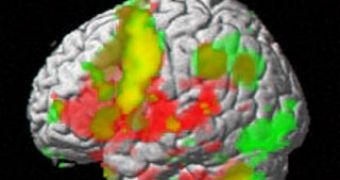In severe cases or facing patients that are struggling to breathe, the current medical approach is to deliver pure oxygen and see if the patient's health condition improves.
But increasing evidence points out that inhaling pure oxygen can actually damage the brain. A new UCLA research examined what is happening during oxygen therapy by brain-imaging. "For decades, the medical community has championed 100 % oxygen as the gold standard for resuscitation. But no one has reported what happens inside our brains when we inhale pure oxygen," explained Ronald Harper, distinguished professor of neurobiology at the David Geffen School of Medicine at UCLA.
Harper's team used functional magnetic resonance imaging (fMRI) to get detailed pictures of what happens inside the human brain during two different breathing cases. Increased blood flow determined by the turn on of different brain areas makes them glow on the image.
14 healthy children, aged 8 - 15, had to inhale 100 % oxygen, while their breathing and heart rates were recorded. After 8 minutes, when the children' respiration returned to normal, the team had them breathe a gas mix made of 5 % carbon dioxide and 95 % oxygen.
Scans in the two situations were analyzed. "When the children inhaled pure oxygen, their breathing quickened, resulting in the rapid exhalation of carbon dioxide from their bodies. The drop in carbon dioxide narrowed their blood vessels, preventing oxygen from reaching tissue in the brain and heart", said coauthor Paul Macey, associate researcher in neurobiology.
On the scans, 3 brain areas suddenly heated up: the hippocampus (controlling blood pressure); the cingulate cortex (controlling pain perception and blood pressure); and the insula, which assesses physical and emotional stress.
The intense activity turned on the hypothalamus, involved in regulating the heart rate and hormonal outflow. "Several brain areas responded to 100 % oxygen by kicking the hypothalamus into overdrive. The hypothalamus overreacted by dumping a massive flood of hormones and neurotransmitters into the bloodstream. These chemicals interfere with the heart's ability to pump blood and deliver oxygen - the opposite effect you want when you're trying to resuscitate someone", Harper explained.
The carbon dioxide-oxygen mix did not trigger the hypothalamus' turn on. "Adding carbon dioxide to the oxygen relaxed the blood vessels, allowed oxygen to reach the heart and brain, calmed the hypothalamus and slowed the release of dangerous chemicals. Pure oxygen kindles the match that fuels a forest fire of harm to the body," said Harper. "But a little whiff of carbon dioxide makes it all go away", Macey added.
The finding strongly points to the addition of carbon dioxide to oxygen therapy, especially for resuscitation, oxygen administration for over a few minutes, stroke, heart attack, carbon monoxide poisoning and other long-term oxygen therapies.
Many European hospitals already resuscitate patients with room air (a mix of nitrogen, oxygen and carbon dioxide) or oxygen and carbon dioxide mixes.

 14 DAY TRIAL //
14 DAY TRIAL //